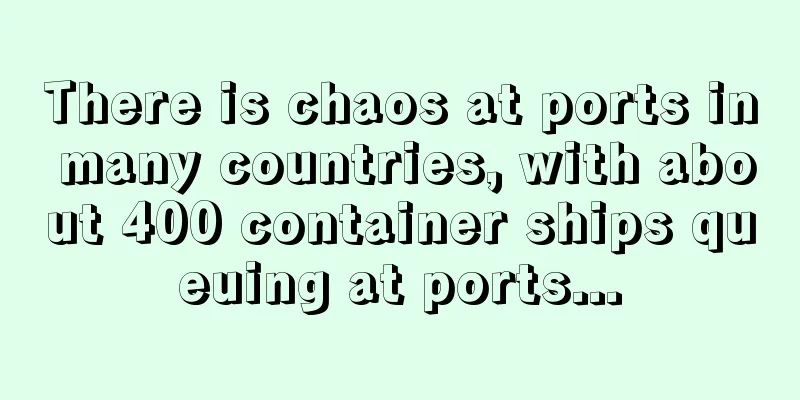There is chaos at ports in many countries, with about 400 container ships queuing at ports...

|
Ports in many countries around the world are in chaos. There are now about 400 container ships stuck in queues at ports waiting to dock. The shipping industry is facing its biggest crisis in 65 years.
Due to the resurgence of the COVID-19 epidemic, factories in many places have stopped production, ports have stopped operating, and container ships are unable to enter the port and dock. In addition, the long-term lack of supporting infrastructure in ports has seriously affected the loading and unloading efficiency of port containers.
According to the Financial Times, there are currently 22 ships waiting for berths in Los Angeles and Long Beach on the west coast of the United States, and the ships will have to wait at least 12 days before they can stop and anchor .
Maersk said that the situation in Southern California has "worsened" and the number of anchored ships has doubled in the past few weeks . According to the latest data from the Los Angeles Port Signal Platform, there are currently 20 container ships waiting at the Southern California anchorage and 14 ships waiting outside the port . The number of waiting ships has increased from 30 in the previous period to 34 , and the average waiting time for berthing has increased from 5.8 days in the previous period to 6.2 days .
Port congestion has spread to the world, and the situation at ports in many countries, including Asia, is not optimistic. The Chittagong Port in Bangladesh is in the worst situation ever, with more than 40,000 TEUs of imported goods piled up at the dock for nearly two weeks, and more than 50,000 TEUs of goods outside the dock. In addition, more than 20 ships have been waiting to enter the port for more than a week .
Due to the spread of the epidemic, Vietnam's port congestion has worsened in recent days, factories have stopped production, warehouses have been closed, and imported goods cannot be processed. Vietnam's two major ports , Klai Port Terminal and Cai Mep International Port Terminal ( TCIT ), have notified that they will suspend the acceptance of some containers from August 5 , further aggravating the port congestion problem.
Due to the increasing number of COVID-19 cases, the Philippines announced a blockade of the Greater Manila area from August 6 to August 20. Congestion at the Port of Manila has intensified, containers have continued to pile up , and customs clearance has been slow or even stagnant.
Due to the epidemic, China's Ningbo Meishan Port also suspended all container inbound and outbound services from 3:30 am on August 11 .
As the epidemic spreads, ports are shut down, and container ships are unable to dock. Global shipping congestion has further intensified, which is bound to have a serious impact on the global commodity supply chain and delay port deliveries. At the same time, shortages of goods in warehouses around the world may lead to problems such as rising commodity prices! Global port congestion |
>>: Russian e-commerce giant Ozon signs delivery agreement with Kazpost
Recommend
What is Rael? Rael Review, Features
Rael is an online store that sells feminine produc...
46% of retailers added Halloween collections this year
New research commissioned by Perfetti Van Melle, ...
TikTok becomes the new search engine for Generation Z in the United States
Recently, a young American named Ja'Kobi Moor...
What is Snowball Station? Snowball Station Review, Features
Xueqiu Off-site has been focusing on Amazon off-s...
Japan's preference for cash declines as e-commerce takes hold
Although Japan is a largely cash-based economy, e...
New outlet! Another platform is open to Chinese sellers
A two-way journey between cross-border e-commerce...
Price surge! The US market is seriously overwhelmed, and the short-selling price may break 70
Due to the serious overcrowding of air cargo term...
What is Zeepay? Zeepay Review, Features
<span data-docs-delta="[[20,{"gallery"...
What is Ria Money Transfer(Ria)? Ria Money Transfer(Ria) Review, Features
Ria Money Transfer (Ria) , a subsidiary of Eurone...
What is LianLian Link? LianLian Link Review, Features
LianLian Link is an independent cross-border e-com...
As the US snowstorm hits, Etsy releases hardcore subsidies
Recently, a snowstorm hit the United States, and ...
What is Magic Cube Cloud Warehouse Overseas Warehouse? Magic Cube Cloud Warehouse Overseas Warehouse Review, Features
Magic Cube Overseas Warehouse is committed to prov...
Online sales accounted for 44%, and Neiman's in the United States grew strongly
Recently, the US Neiman Marcus Group announced th...
Etsy reveals top shopping trends for 2022
It is understood that Etsy has announced its pred...
What is Chrisland Overseas Warehouse? Chrisland Overseas Warehouse Review, Features
Chrisland Overseas Warehouse (Suzhou Chrisland In...









